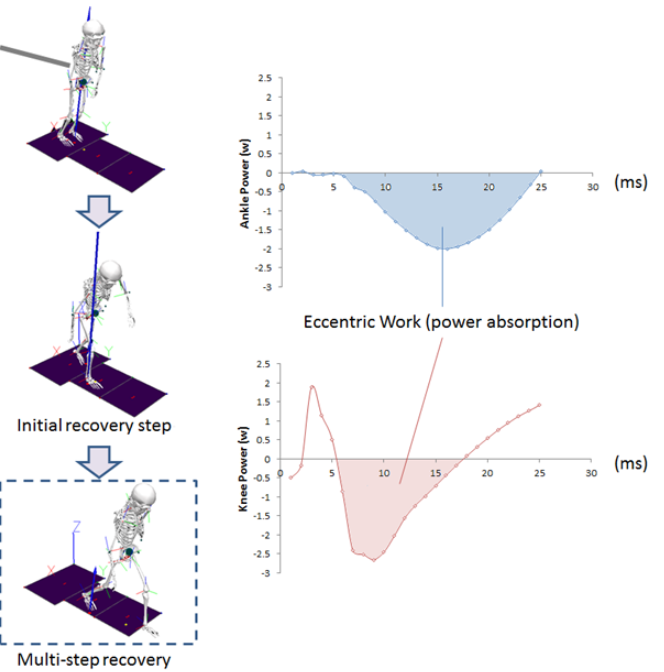For the senior population, fall-related injuries often lead to loss of independent lifestyles and enormous medical costs. Tripping is the leading cause of falls, and often results in a forward loss of balance. Dynamic balance after a trip could still be restored by an effective recovery step to prevent the fall. The effectiveness of the recovery step depends on both position and timing factors – the foot should be ‘positioned sufficiently” in front of the whole body centre of mass within a certain ‘time limit’. In the process of balance recovery, the recovery leg needs to absorb the falling momentum by knee and ankle eccentric work. We aimed to identify the biomechanical requirements of such recovery steps during unanticipated forward falling in older adults. For this investigation, biomechanical characteristics of the initial recovery step were compared between single- and multi-step recovery actions. A single step recovery should essentially fulfil all requirements of balance restoration, while a multi-step recovery distributes the entire burden over several steps. Compared to multi-step recoveries, the single-step response was, therefore, hypothesised to play a larger role for balance recovery.
We employed a commonly-used tether-release protocol to test our hypothesis. Fifteen healthy older participants maintained forward leaning position with a cable supporting them from the back (see figure). At random timing, the cable was released to induce a forward fall, essentially requiring recovery actions. These recovery actions were recorded using a Vicon 3D motion capture system and AMTI force platforms to analyse the biomechanical characteristics of the recovery steps. We determined the margin of stability as the distance from the extrapolated centre of mass position to the base of support boundary, indicating spatial stability. Dynamic balance is secured when margin of stability is positive. Available response time was computed as the estimated time for centre of mass to reach the base of support boundary.

Figure: (left) whole body model during a multiple-step recovery, (right) ankle and knee eccentric work and power absorption during the first recovery step.
Publication
Nagano, H., Levinger, P., Downie, C., Hayes, A., Begg, R.K. 2015. Contribution of Lower Limb Eccentric Work and Different Step Responses to Balance Recovery among Older Adults. Gait and Posture, 42 (3): 257-262. DOI: 10.1016/j.gaitpost.2015.05.014
About the Author

Dr Hanatsu Nagano
Institute of Sport, Exercise and Active Living (ISEAL), Victoria University, Melbourne
Dr Nagano is a postdoctoral research fellow at the Institute of Sport, Exercise and Active Living. His area of expertise is gait biomechanics specialising in falls prevention among senior adults. He is an honorary physiologist at Austin Health.
Copyright
© 2018 by the author. Except as otherwise noted, the ISPGR blog, including its text and figures, is licensed under a Creative Commons Attribution-ShareAlike 4.0 International License. To view a copy of this license, visit https://creativecommons.org/licenses/by-sa/4.0/legalcode.
ISPGR blog (ISSN 2561-4703)
Are you interested in writing a blog post for the ISPGR website? If so, please email the ISGPR Secretariat with the following information:
- First and Last Name
- Institution/Affiliation
- Paper you will be referencing
